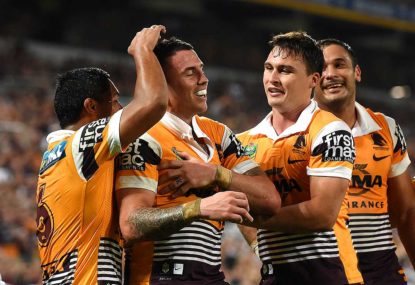NRL News: Maguire happy with Papi's claims for Origin berth, Souths set to name new defence coach
Refusing to be drawn on who will wear the NSW State of Origin No.6 jersey, incoming Blues coach Michael Maguire says he won't rule…

Venues can make or break your experience of a game. A Tigers win at Campbelltown is much more breathtaking than a Tigers win at Allianz.
Similarly, a Sea Eagles loss at Brookvale is going to mean something different from a Sea Eagles loss at ANZ.
So integral are the venues to team spirit that the current stadium restructure is undoubtedly going to change the culture and experience of the game. Over the next couple of weeks, I’m planning to outline how each team in the competition is going to be affected by the plans unveiled by Mike Baird over the last couple of days.
At first glance, starting with the Broncos might seem like an unusual approach. What does the reorganisation of Sydney rugby league venues have to do with Brisbane?
Actually, I think that the centralisation of Sydney rugby league is going to place the non-Sydney teams at a distinct advantage. Whereas most Sydney teams will eventually be playing out of a couple of big venues, the Storm, Raiders, Knights, Broncos, Titans, Cowboys and Warriors will still be able to experience ‘home’ games in a local and meaningful way.
History shows that all of these teams exhibit strong winning streaks at their home grounds. In large part, that’s because they are all the sole rugby league custodians of their home grounds. In some cases, they are the main custodians from any football code.
In the past, Sydney teams have often been perceived to possess a more richly historical and emotionally galvanising connection to their home grounds. After all, Leichhardt Oval is over seventy years older than Cbus Super Stadium, while Belmore Sports Ground is some eighty years older than AAMI Park.
With the move to centralise and upgrade Sydney rugby league, however, that relationship is going to be reversed. All of a sudden, venues outside Sydney are going to feel as if they possess a more historical and authentic connection to the game’s heritage.
Out of all those venues, Suncorp Stadium will probably turn out to feel the most traditional. Construction broke ground at Lang Park in 1911. Another fifty four years elapsed before Mt Smart opened in 1965, followed by Hunter (1967), GIO (1977), 1300SMILES (1994), Cbus (2007) and AAMI (2010).
That heritage makes Suncorp one of the most intimidating cauldrons in the competition. In fact, you could say that Suncorp now offers the same experience Baird wants to implement through the new and improved ANZ – a centralised rugby league venue that manages to accommodate every team in the state along with the state itself in representative events such as Origin and international Tests.
That might sound like a strange thing to say. After all, isn’t Suncorp the Broncos’ home ground? Nobody could confuse it with 1300SMILES or Cbus.
Nevertheless, Suncorp also feels as it it contains 1300SMILES and Cbus. Whenever the Cowboys and Titans turn up in Brisbane, they may not be playing a home game, but it never quite feels as if they’re playing an away game either.
In part, that’s due to the special relationship between Suncorp and Origin. While the Blues technically have ANZ as their home ground, the Maroons have always enjoyed a much more organic relationship with Suncorp.
At the same time, it comes down to the differences between NSWRL and QRL. Since there are more footy teams in NSW, as well as more of an NRL culture in Sydney, NSWRL as a whole is defined by the historical rivalries between teams as much as by the overarching rugby league culture of the state.
In Queensland, however, things are different. Until relatively recently, Brisbane were the only Queensland team. For a time, playing Queensland in Origin more or less meant playing the Broncos.
While the Cowboys and Titans have changed that, they haven’t changed it all that much. Instead of local barnies forming among the Queensland three, there’s a sense that Brisbane, North Queensland and Gold Coast are always playing, in some sense, for their state, which is perhaps why the Maroons have such a strong sense of cohesion and culture as well.
For all those reasons, Suncorp is unique in the competition for the way in which it manages to represent the Broncos while also leaving space for the Cowboys and the Titans, as well as the way in which it manages to stand for Brisbane sporting culture specifically while also shining as an emblem of Maroon pride.
That, in a nutshell, is what Baird wants to come out of this restructure. He wants ANZ to become a genuine answer to Suncorp. However, unless the culture and history of New South Wales Rugby League changes overnight, it’s not going to happen.
And that’s not a dig at NSWRL. As a Tigers and Bulldogs supporter, I love Sydney footy. But Sydney footy is very different from Queensland footy. While the new and improved ANZ is definitely going to change the NRL as we know it, it can only strengthen Suncorp in the short term.
Then again, maybe New South Wales footy fans need to stop fearing Suncorp and start thinking about what we can learn from it. From that perspective, the next couple of years are going to be a real learning curve for players and fans alike.